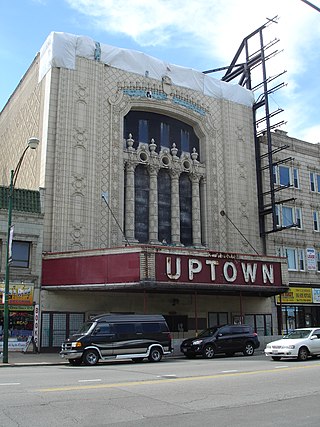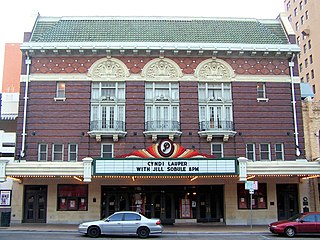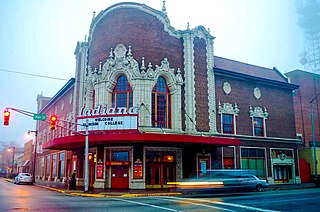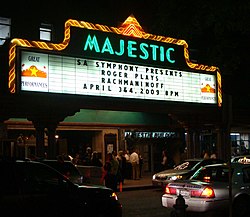
The Castro Theatre is a historic movie palace in the Castro District of San Francisco, California. The venue became San Francisco Historic Landmark #100 in September 1976. Located at 429 Castro Street, it was built in 1922 with a California Churrigueresque façade that pays homage—in its great arched central window surmounted by a scrolling pediment framing a niche—to the basilica of Mission Dolores nearby. Its designer, Timothy L. Pflueger, also designed Oakland's Paramount Theater and other movie theaters in California during that period. The theater has over 1,400 seats. The theater's ceiling is the last known leatherette ceiling in the United States and possibly the world. Another leatherette ceiling was demolished just a few years ago. To make the ceiling look as though it is leather requires a special technique regarded as lost today.

The Hawaii Theatre is a historic 1922 theatre in downtown Honolulu, Hawaii, located at 1130 Bethel Street, between Hotel and Pauahi Streets, on the edge of Chinatown. It is listed on the State and National Register of Historic Places.

A movie palace is any of the large, elaborately decorated movie theaters built between the 1910s and the 1940s. The late 1920s saw the peak of the movie palace, with hundreds opening every year between 1925 and 1930. With the advent of television, movie attendance dropped, while the rising popularity of large multiplex chains in the 1980s and 1990s signaled the obsolescence of single-screen theaters. Many movie palaces were razed or converted into multiple-screen venues or performing arts centers, though some have undergone restoration and reopened to the public as historic buildings.

The Fox Theatre is a performing arts center located at 2211 Woodward Avenue in Downtown Detroit, Michigan, near the Grand Circus Park Historic District. Opened in 1928 as a flagship movie palace in the Fox Theatres chain, it was at over 5,000 seats the largest theater in the city. Designed by theater architect C. Howard Crane, it was listed on the National Register of Historic Places in 1985.

Freeman Coliseum is a sports and concert venue located in San Antonio, Texas. It has been host to thousands of events including the San Antonio Stock Show & Rodeo, concerts, trade shows, motor sports, circus, professional sports including professional bull riding, basketball, hockey, boxing and wrestling. It was the largest indoor arena in San Antonio until HemisFair Arena opened in 1968. Since then, many top recording artists have made their San Antonio concert debuts at the Coliseum.

The Grand Lake Theatre is a historic movie palace located at 3200 Grand Avenue and Lake Park Avenue in the Grand Lake neighborhood of Oakland, California.

The Stanley Theater at Kennedy Boulevard and Pavonia Avenue is near Journal Square in Jersey City, New Jersey.

The Paramount Theatre is a live theatre venue/movie theatre located in downtown Austin, Texas. The classical revival style structure was built in 1915. The building was listed in the National Register of Historic Places on June 23, 1976.

John Adolph Emil Eberson was an Austrian-American architect best known for the development and promotion of movie palace designs in the atmospheric theatre style. He designed over 500 theatres in his lifetime, earning the nickname "Opera House John". His most notable surviving theatres in the United States include the Tampa Theatre (1926), Palace Theatre Marion (1928), Palace Theatre Louisville (1928), Majestic Theatre (1929), Akron Civic Theatre (1929) and Paramount Theatre (1929). Remaining international examples in the atmospheric style include both the Capitol Theatre (1928) and State Theatre (1929) in Sydney, Australia, The Forum (1929), Melbourne, Australia), the Lewis J. Warner Memorial Theater (1932) at Worcester Academy in Worcester, Massachusetts and Le Grand Rex.

An atmospheric theatre is a type of movie palace design which was popular in the late 1920s. Atmospheric theatres were designed and decorated to evoke the feeling of a particular time and place for patrons, through the use of projectors, architectural elements and ornamentation that evoked a sense of being outdoors. This was intended to make the patron a more active participant in the setting.

The culture of San Antonio reflects the history and culture of one of the state's oldest and largest cities straddling the regional and cultural divide between South and Central Texas. Historically, San Antonio culture comes from a blend of Central Texas and South Texas (Southwestern) culture. Founded as a Spanish outpost and the first civil settlement in Texas, San Antonio is heavily influenced by Mexican American culture due to Texas formerly being part of Mexico and, previously, the Spanish Empire. The city also has significant German, Anglo, and African American cultural influences. San Antonio offers a host of cultural institutions, events, restaurants and nightlife in South Texas for both residents and visitors alike.

The Majestic Theatre is a theatre located at 4126-4140 Woodward Avenue in Midtown Detroit, Michigan. It was listed on the National Register of Historic Places in 2008.
Majestic Theatre or Majestic Theater may refer to:

The Majestic Theatre is a performing arts theater in the City Center District of Downtown Dallas. It is the last remnant of Theater Row, the city's historic entertainment center on Elm Street, and is a contributing property in the Harwood Street Historic District. The structure is a Dallas Landmark and is listed on the National Register of Historic Places.

The State Theatre is a historic theatre in Minneapolis, Minnesota, USA. It is one of four restored theatres in the Hennepin Theatre District.
The Woodlawn Theatre is located in San Antonio, Texas, and is one of the few theaters remaining designed by architect John Eberson. Eberson also designed the Majestic Theatre in San Antonio. The Woodlawn Theatre is designed in an art deco fashion, and was previously a prevalent movie theater, including hosting the world premiere of The Alamo in 1960. As of 2012, it is located in an area of San Antonio featuring buildings designed in art deco fashion known as the Deco District.

Robert J. O'Donnell (1891–1959) was an American businessman and philanthropist who, with partner Karl Hoblitzelle, managed the Interstate Theater chain as vice president and general manager from 1925 until his death from lung cancer in 1959. O'Donnell is best known for helping facilitate the growth of the "Majestic" chain of theaters during the "classical Hollywood narrative" and later for his philanthropic work both with the Variety Club Children's Charity and the Robert J. O'Donnell Film Series Endowment Fund for the Dallas Museum of Fine Arts.

The Indiana Theatre is a historic theater in Terre Haute, Indiana, United States. It was added to the National Register of Historic Places on November 13, 1997 and is located in the Wabash Avenue-East Historic District. It opened on January 28, 1922. The theatre was built by Terre Haute resident T. W. Barhydt and was designed by John Eberson. Eberson, who later developed the atmospheric theater style of movie palace, first experimented with atmospheric design elements at the theatre. Eberson stated, "Into this Indiana Theatre I have put my very best efforts and endeavors in the art of designing a modern theatre such as I have often pictured as what I would do were I given a free hand." Through this quote Eberson suggests that the Indiana Theatre embodies the raw beginning of his experiment with a "dream" theater that marked the beginning shift to his atmospheric style.

Karl Hoblitzelle was an American theater owner, real estate investor, and philanthropist. He was the co-founder of the Interstate Theaters Company, a chain of vaudeville theaters, now a subsidiary of The Walt Disney Company. He was the first theater owner to add air conditioning to movie theaters in the United States, and the first to add sound in the Southwest. He also helped support the construction of the University of Texas Southwestern Medical Center.



























